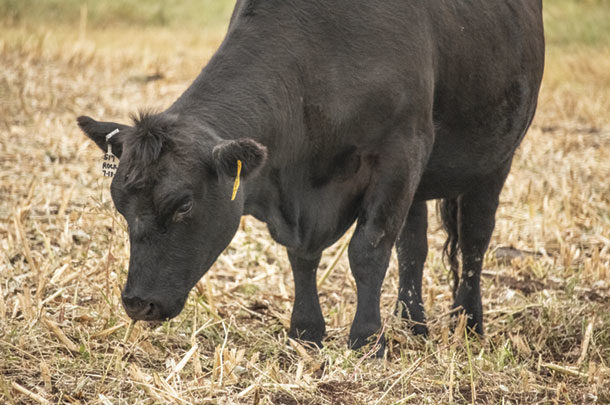It’s an important time for both cow and calf, and the nutrition of the pregnant female during the two to three months leading up to calving will have impacts on both the calf born this year and next year’s calf too.
Late gestation is the last chance to get the cow in good condition before calving and breeding. Good condition at breeding will increase pregnancy success, thereby impacting next year’s calf. Numerous studies have shown that having a cow with a body condition score (BCS) of 5 or greater at calving will increase breeding success.
This is because BCS affects the amount of time it takes the cow to start cycling again after calving. A study in Wyoming showed that cows with a BCS of 5 to 6 had an overall pregnancy rate of 88%, while those with a BCS of 4 had a pregnancy rate of 69% during a 60-day breeding season.
Late-gestation nutrition is also important to the productivity of this year’s calf. Most of the fetal growth happens during the three months leading up to calving. Thus, nutrition during this period can have huge impacts on calf health and growth. Calves of cows that don’t get enough protein or energy during the last trimester have been shown to have lowered weaning weights, delayed age at puberty and lowered immune responses, resulting in increased sickness and death rates. A 1,200-pound cow requires 12.9 pounds of total digestible nutrients (TDN) and 1.9 pounds of crude protein (CP). If she can eat 2% of her bodyweight, she would need a diet that contains 54% TDN and 7.9% CP.
A little supplement can go a long way. Research conducted in Nebraska has shown that feeding 1 pound of a distillers-based supplement (90% TDN, 31% CP) to cows grazing dormant Sandhills range in late gestation will improve weaning weights by 20 pounds. Giving this amount of supplement to the cows during the last trimester also increased the hot carcass weight and quality grade of the steer calves and resulted in heifer calves reaching puberty at younger age.
This small change in the nutrition of the gestating cow had an impact on the calf despite having little impact on cow condition or reproduction. The BCS of nonsupplemented cows at calving was good with the average of 4.8, and supplementation increased the BCS of the cows to 5.2. As expected, given the BCS of the cows, there were no differences in pregnancy rates in the cows.
Calving season
To reduce calving difficulties, give bred heifers the protein and energy she needs. Bred heifers are still growing and will have nutrient needs 10%-15% greater than mature cows. Therefore, managing bred heifers separately from mature cows can help one meet the needs of first-calf heifers without overfeeding the mature cows. Many people think that reducing the amount of energy or protein fed to bred heifers in late gestation will reduce birthweight and thus calving difficulty. The opposite is true.
Underfed bred heifers have less stamina to get through the calving process, which results in increased calving difficulty despite the calf being smaller. Less feed also leads them to be in poorer body condition after calving. This increases the risk that she will either not breed back or breed back later in the breeding season.
Delayed breedback increases the likelihood that she will fall out of the herd next year due to not rebreeding. Overall, bred heifers that do not get enough energy or protein during the last trimester experience more calving difficulty, conceive later in the breeding season and their calves have increased sickness, death and lower calf weaning weight.
So what does a bred heifer need? To have her obtain 85% of mature bodyweight, the typical targeted rate of gain is around 1 pound per day up to calving. A 950-pound bred heifer in the last trimester needs to consume 10.6 pounds of TDN and 1.9 pounds of CP to gain 1 pound per day. If she is eating 2% of her bodyweight, she would need a diet that is 55% TDN and 8.4% CP. A good-quality hay can meet her needs.
A side note here: I come across many people that think a hay is good quality, but when it is tested, it falls short of the content suggested above. Bottom line: Testing your hay is the only way to know you are meeting your goals. If grazing dormant range or consuming other low-quality forages, then protein and energy supplementation would be needed. For heifers grazing on dormant range in the Sandhills of Nebraska (50% TDN, 6.5% CP), 3 pounds of dried distillers grains would meet both the energy and protein need.
Late gestation is a critical time in cow-calf production. Many of the impacts plane of nutrition has during this time are not seen until much later. Remember, you are feeding not only the cow, but also the calf. Proper nutrition during late gestation will ultimately result in better breeding success and healthier, more productive calves. ![]()
PHOTO: Third-trimester nutrition and condition of the cow are significant factors not just for the dam, but just as critical for development of the calf heading into a full year. Photo by Lynn Jaynes.

-
Mary Drewnoski
- Beef Systems Specialist
- University of Nebraska – Lincoln Animal Science
- Email Mary Drewnoski







